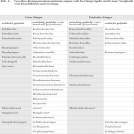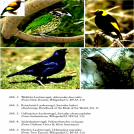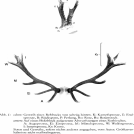zoology
Flight of Shimmering Light: Exploring Insights into Hummingbird Biology from Comparative Morphology
The 377 species of hummingbirds (Family Trochilidae) occur across the Americas and are considered the most colorful group of birds in the world. This status is achieved due to the majority of species exhibiting various degrees of brilliant plumage iridescence. Hum- mingbirds also include the smallest birds in the world, with the Bee… read more

Zur Gestaltbiologie der Schlangen
In the last years of his life, it was a great concern of Mathias Küster (1950–2022) to write down his ideas on the gestalt biology of snakes, even though he no longer saw himself in a position to do so alone. However, the project, which was started together in 2021, could only be completed after his death. With regards to content, the… read more

Parrots and People
The approximately 398 species of living parrots (macaws, parakeets, cockatoos, etc.) comprise a more or less homogeneous group of birds found mostly in tropical and subtropical regions. No other group of wild birds has attracted such strong human interest, and conse- quently parrots are the most popular avian pets around the world, from the… read more

Über den harmonischen Einklang von Vogelstimme und Flugbewegung
One classic example of Goethe's principle of compensation are the galliformes. The luxurious splendour of the males’ plumage, for example the capercaillie, golden pheasant and peacock, has to be seen in close relation to the increasingly elaborate courtship behaviour and the decreasing participation in caring for the offspring. However, it is… read more

Gedanken zur Entwicklung der Gruppenseele am Beispiel des Vogelzugs
Each year, some 50 billion migratory birds fly from their breeding grounds to their winter quarters, some of these being far away. Today, we know both the flyways taken by many types of bird and that migratory birds possess a celestial and a magnet compass. Furthermore, evidence is available to prove that any migratory bird, provided it has… read more
Die Bauwerke der Laubenvögel
The constructions of bower birds — remarks on the principle of compensation
The bowerbirds of New Guinea and Australia build laborious bowers and decorate the courtship sites around them. The artistic arrangement is unique in the bird world. Just as the males of the closer related birds of paradise display their splendid plumage, the… read more

Eine Übersicht zur Gliederung der Blumentiere mit besonderer Berücksichtigung der Korallen
After a general overview of the phylum Cnidaria with their bilayered structure and two Characteristic life forms, polyp (sessile) and medusa (mobile), the Anthozoa, which comprise their own class, are examined in detail by focusing on the colony- forming Anthozoa, which are also referred to as corals. We can distinguish two fundamentally… read more

Überlegungen zur Gestaltbiologie des Bienenschwarms
Reflections on the formative biology of bee swarms
Throughout their entire life cycle, honey bees are closely connected to their environment and receive important shaping stimuli from their surroundings. Thus it is not a gene that determines whether an egg will turn into a worker or a queen, but rather the shaping stimulus arising from… read more

Zur Metamorphose der Geweihgestalten
The metamorphosis of antler forms
Among the many forms of antlers there is a formative law that is common to them all, an 'archetype' in the Goethean sense. Firstly, this 'archetypal antler' is grasped as a common Bauplan, as a scheme of different parts and their spatial relations to one and other. Elements of this Bauplan, which by… read more

Von der Symbiose zum sogenannten Brutparasitismus
From symbiosis to brood parasitism Part I: From the life of the cuckoo
Using the cuckoo family as an example, this article shows that likening the cuckoo to a brood parasite is not generally justified, as there are many cuckoo species that care for brood. Some of them - possibly the oldest - form social groups and brood communities… read more

